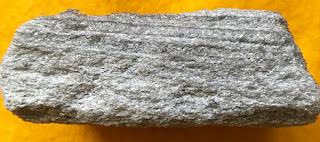Igneous rocks are derived from magma = "red-hot," molten matter emanating from inside the Earth.
The above diagram shows the basic classification of igneous rocks. A substitute rock for rhyolite is any glassy textured rock, like pumice, obsidian, or pele's hair. Another name for "dunite" is peridotite.
This cross section of the Earth' crust shows where the major types of igneous rocks form. Note: basalt = flood basalt (on the continents) and pillow basalt (on the floor of the oceans).
This diorama, which is a more graphic way of showing the table presented at the beginning of this post, shows representative pictures of the major types of igneous rocks. These specimens are mostly hand-size or smaller.
The rocks above the centimeter scale in the diorama are volcanic (extrusives) that cooled quickly from magma extruded onto the Earth's surface, whereas those below the scale are plutonic (intrusives) that cooled slowly from magma bodies inside the Earth.
For each extrusive rock, there is a counterpart intrusive rock. For example, pumice (as well as rhyolite), and their underground (intrusive) counterpart granite, generally have similar chemical compositions (i.e., they both have minerals rich in quartz and potassium feldspar). Andesite and its underground (intrusive) counterpart diorite have their own similar chemical composition (e.g., they both have minerals low in quartz and intermediately high in potassium feldspar). Basalt and its underground (intrusive) counterpart gabbro have their own similar chemical composition (e.g., they both have minerals without quartz and those high in potassium feldspar).
 |
| specimen 9 cm height |
Pumice, from the 1980 eruption of Mt. Saint Helens, Washington.
Side view of the same specimen, showing the layers of pumice.
 |
| specimen 8.5 cm height |
A different type of pumice (locality unknown), showing "air holes." Pumice is so "light" in density, it can float on water.
 |
| specimen 5 cm height |
Obsidian is volcanic glass with a low amount of iron, which produces the black color. Obsidian forms by rapid cooling. This kind of rock, which breaks into very sharp pieces, is used commonly for making arrowheads.
 |
| specimen 8.5 cm height |
"Snowflake obsidian," a natural volcanic glass containing the mineral cristobalite (= the white "snowflake" crystals consisting of radially clustered crystals). The cristobalite formed due to the partial crystallization of the glass. This specimen is from Millard County, Utah.
 |
| specimen 7 cm long; it comes apart live a stand of hair |
Pele's "hair" is a volcanic glass spun by blowing-out during quiet fountaining of fluid lava. It is named for the Hawaiian goddess of volcanoes, Pele.
 |
| specimen 22.5 cm height |
This large cobble of rhyolite shows "flow banding" caused by flowage of crystals before the magma solidified.
 |
| specimen 9.5 cm height |
Crystals in this piece of granite are visible because the magma cooled very slowly (thousands of years) underground. The large pink crystals are potassium feldspar. The black mineral is biotite, and the other minerals are quartz (gray) and sodium-rich plagioclase (white).
 |
| specimen 9.5 cm height |
Andesite (a common rock in the Andes Mountains of South America-hence the name "andesite"). The crystals are not visible because they cooled quickly and did not grow to a larger size.
 |
| specimen 6 cm height |
Diorite is the intrusive-rock equivalent of andesite. Hornblende is a common constituent, as is intermediate form of plagioclase (a mixture of both sodium-bearing and calcium-bearing plagioclases).
 |
| specimen 11 cm height |
Basalt is the most common rock on the ocean floor; in fact, its makes up the ocean floor if you subtract the mud and sand that settled on top of it. The iron content of basalt makes it black in color. Basalt is also found on the Moon = the dark patches (the mare).
 |
| specimen 7m height |
This is a basalt stalactite (a dripping from the top of a lava tube in New Mexico).
 |
| specimen 13.5 cm height |
This basalt-lava volcanic "bomb," while still molten, twisted in the air before hitting the ground.
 |
| specimen 4.5 cm width |
Basalt can contain inclusions, called xenoliths (="stranger rocks"), which consists of a fragment of a plutonic rock. The xenolith was picked up by the basaltic magma as it moved upward toward the surface of the Earth.
 |
| specimen 3.5 cm height |
Gabbro has visible crystals because it cooled slowly underground. This rock, which is very low in quartz, has abundant hornblende and calcium-rich plagioclase. Gabbro is found also on the Moon = the "white" patches.
 |
| specimen 9 cm height |
This rock, called dunite, consists almost entirely of olivine.



















Excellent post! I’m new to using rocks and stones in my yard and this gave me a lot of ideas on how to use them creatively.
ReplyDelete